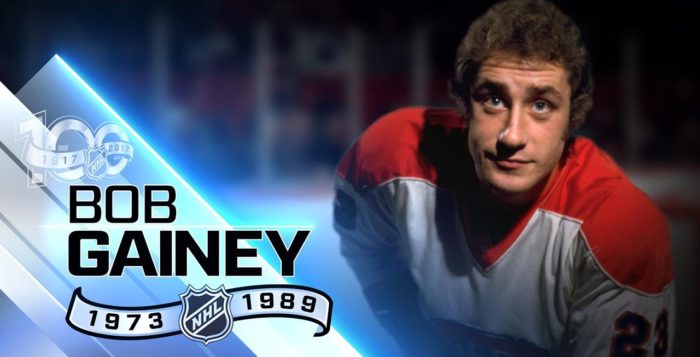This Day in Hockey History – July 17, 1989 – Nothing Ventured, Nothing Gainey
Bob Gainey epitomized the role of “defensive forward.” In his 16 seasons in the NHL, he used those skills to lead the Montreal Canadiens to five Stanley Cup championships while he took home the Frank J. Selke Trophy the first four times it was awarded. At the end of such a successful career, Gainey announced his retirement on July 17, 1989.
From the ages of 7 until 15, Gainey actually played as a defenseman. He then switched to forward as a left wing and soon thereafter played junior hockey with the Peterborough Petes under Roger Neilson’s direction. Gainey later said, “Playing for the Petes with a coach like Roger, who structured the Petes in team play, fit my style.” His style and size attracted the attention of the Montreal Canadiens.
After they selected him as their first-round pick (8th overall) in 1973, Gainey only ever played for one NHL team. They made the playoffs every single season of his career. Of the six finals they played in, they won five of them. Gainey earned the Conn Smythe Trophy as playoff MVP following the fourth consecutive championship in 1979, and his teammates lifted him on their shoulders in celebration. As of 1982, he took on the responsibility of captaining the team and led them to his final Stanley Cup in 1986. The rematch with the Calgary Flames in 1989 went the other way, and Gainey retired right after that one near-miss.
At Gainey’s retirement, he had played in 1,160 regular-season games (239G, 263A, 502P) and 182 postseason games (25G, 48A, 73P). “Most players at some point realize that they’re going to have to make a career change, whether it be in six months, a year or three years,” Gainey said in an interview. “I always had certain traits about recognizing the team composition and how things worked and keeping an eye open for what was going on. I knew in a number of different ways that my playing career was coming to an end. There was a point when Serge Savard, the GM, said that when I was finished playing, he’d be open to talking about some other kind of work in the Canadiens’ organization. That was a window of opportunity that was opened for me before I actually got to the point.”
Gainey still is best known for having received the award for the NHL’s best defensive forward in each of the first four years since the Selke’s introduction in 1978. Despite not winning it after that, he remained in the top 10 for the next four seasons. When Gainey prepared to present the award (to Patrice Bergeron who tied his record), he explained what it was like to receive it. “There was usually a year-end conference or banquet … and a very simple awards ceremony. I don’t think there were nominations or finalists. The luncheon was held at a downtown Montreal hotel, the Windsor or the Queen Elizabeth, and different awards would be given out. … The Selke was an award that began after I’d started my NHL career (in 1973-74). Mr. Selke (who died in 1985) always presented it to me.” He then described the traits being recognized with the award. “There have always been players in previous generations who represented that defensive or defensive-balance two-way player, who in the team structure were given that role. … Over time, like everything, there’s been an evolution. That player has become maybe a more complete player, a balanced player of offense and defense, if need be, to really be able to fulfil the role of strong defense in the parts of the game that require it completely.”
After the end of his playing career, Gainey first went to France to play and coach for the Epinal Squirrels, a Tier Two league. He said, “It wasn’t too demanding but it did put me in a position of responsibility.” Having gained experience in coaching, Gainey returned to the NHL to coach the Minnesota North Stars. “I left my playing career right at the time when things were really starting to change in the NHL. There were a lot of ownership changes and changes in locations of teams, plus expansion and the union had changed. We were going into a completely new era but no one really knew that in 1990.” He relocated to Dallas with the team and became general manager. Under his management, they won the 1999 Stanley Cup.
From 2003 to 2010, Gainey returned to the Canadiens, serving as Executive Vice President and General Manager. “For many of the past ten years, I saw myself as a player who was coaching or a player who was managing. I think the player part diminishes with time. It’s hard to keep that sensitivity towards all those things a player has to go through every day. Some of them remain and you can draw on those to come to conclusions in certain situations. All of us use the experiences we had in different situations and with different people and try to apply them to make us more successful than our competitors.” Gainey then came full circle when he became a volunteer senior advisor for the Peterborough Petes of the Ontario Hockey League.
Gainey was inducted into the Hockey Hall of Fame in 1992. “It was something that I didn’t really appreciate enough until I got there,” admitted Gainey. “Hockey is what I’ve done for my life’s work. I’d like to be able to leave a mark alongside people who have left their name and their results on the game. That’s what people who are in the Hockey Hall of Fame have done.” Finally, in 2008, nearly 20 years after he had retired, the Canadiens retired No. 23, the only number Gainey ever wore in the NHL.
Additional Sources:
- https://www.nhl.com/news/bob-gainey-100-greatest-nhl-hockey-players/c-285360444?tid=283865022
- https://www.nhl.com/news/montreal-canadiens-bob-gainey-was-model-selke-trophy-winner/c-299162320
- https://www.hhof.com/htmlSpotlight/spot_oneononep199203.shtml
- https://www.hockey-reference.com/players/g/gainebo01.html














